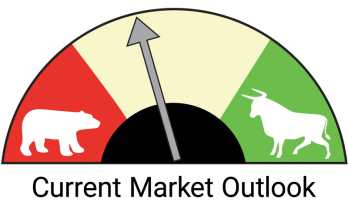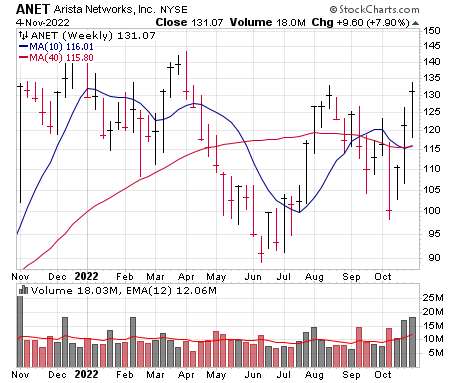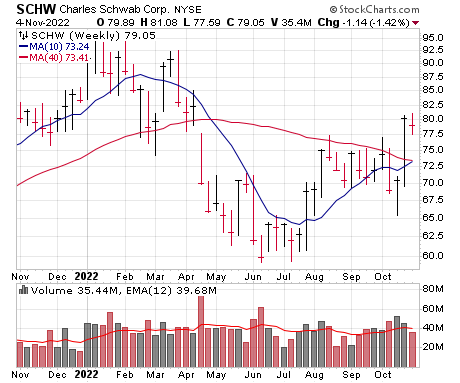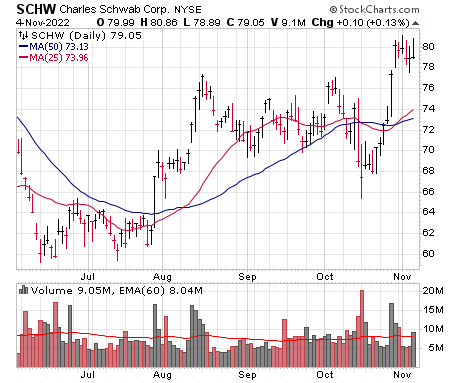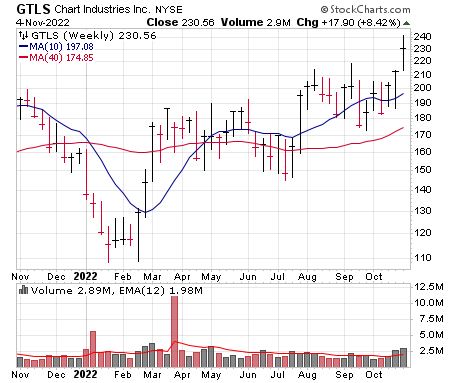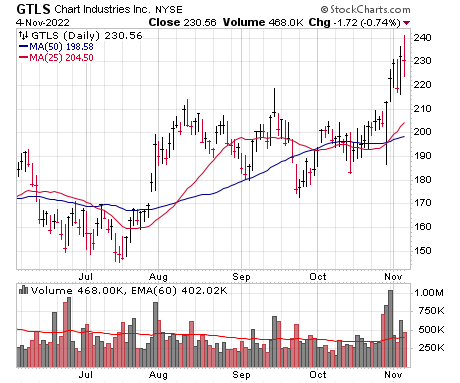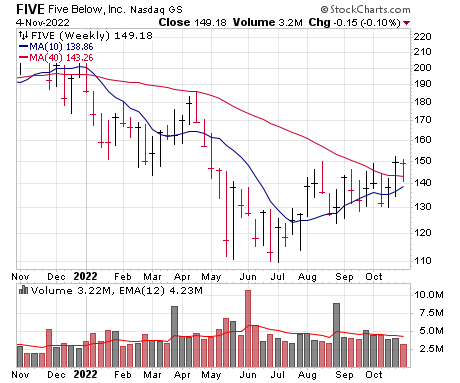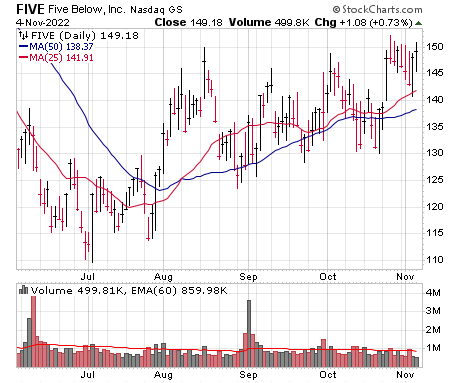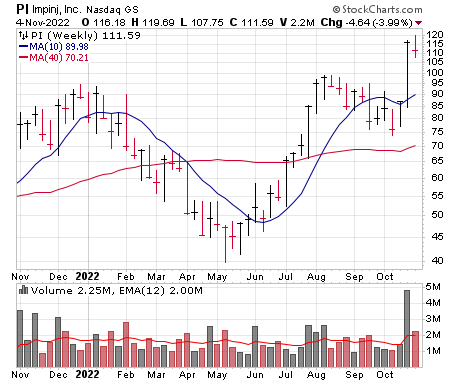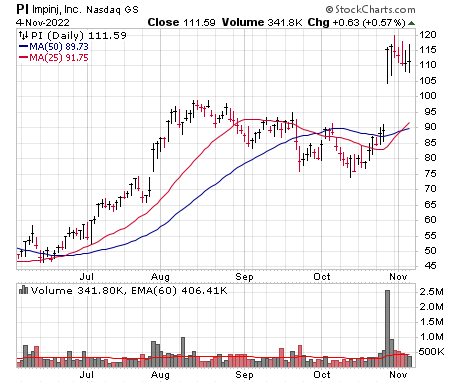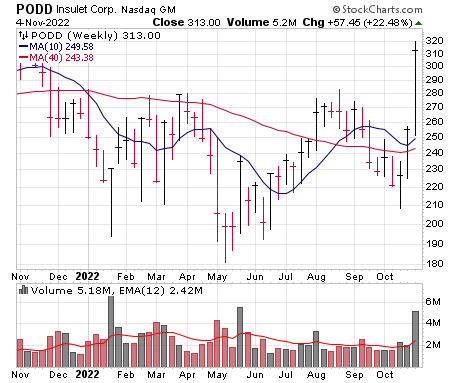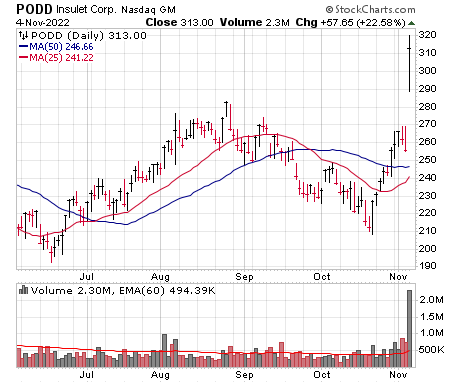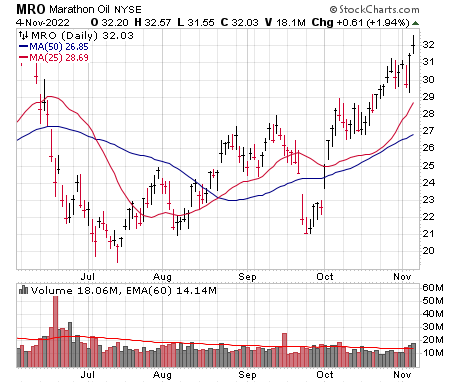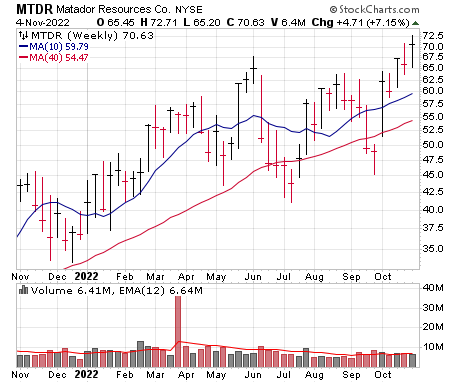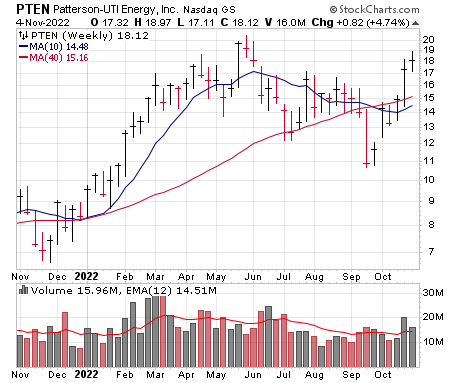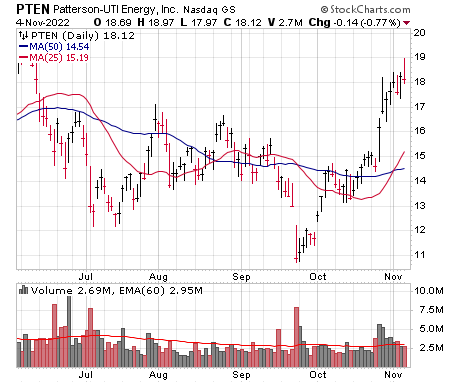Download Issue PDF
Still Iffy, but Some Green Shoots
The major indexes quickly retreated after the prior couple of good weeks, with growth-oriented areas falling the most (the Nasdaq was off 5.7% last week), a lot of stocks once again being rejected near resistance and some old winners (like cloud software last Friday) and popular name (Amazon, etc.) being taken out and shot. Despite that, there are some green shoots out there—by the letter of the law, some broad indexes (like small- and mid-caps) are in intermediate-term uptrends, and we’re also seeing some sectors assert themselves, especially in the commodity space. We’re not bullish, per se, especially as defensive and commodity names usually aren’t the stuff new bull moves are made of—that said, we’ll leave our Market Monitor at a level 4, though our overall advice remains basically unchanged: Hold plenty of cash, honor your stops and, if you do some buying, keep it small.
This week’s list is again heavy on commodity-type names, though we’re also seeing a few recent earnings winners that have some growth to them. Our Top Pick straddles the line between growth and commodity—Chart Industries (GTLS) has a great long-term outlook and is one of the few names to move out to recently all-time highs.
| Stock Name | Price | Buy Range | Loss Limit |
| Arista Networks (ANET) | 131 | 125-129 | 112-114 |
| Charles Schwab (SCHW) | 80 | 77-80 | 69-70 |
| Chart Industries (GTLS) ★ TOP PICK ★ | 235 | 228-238 | 201-206 |
| First Solar (FSLR) | 147 | 141-145 | 123-126 |
| Five Below (FIVE) | 149 | 145-150 | 126-129 |
| Inpinj (PI) | 105 | 101-104 | 87-90 |
| Insulet (PODD) | 304 | 292-303 | 255-260 |
| Marathon Oil (MRO) | 33 | 30.5-32 | 26.5-27.5 |
| Matador Resources (MTDR) | 73 | 68.5-71 | 59-61 |
| Patterson UTI (PTEN) | 19 | 17.5-18.5 | 15.4-15.9 |
STOCK 1
Arista Networks (ANET)
| Price | Buy Range | Loss Limit |
| 131 | 125-129 | 112-114 |
Why the Strength
With Internet data, 3D and video applications seeing exponential growth, the need for networking equipment and data center upgrades is on the rise, especially among mega-cap firms, which are in the midst of capacity upgrades despite the bear market. This trend has been clearly visible in recent quarters for Arista, which designs and sells multilayer network switches that deliver software-driven networking solutions for cloud data centers and other computing environments. Indeed, spending by giant cloud companies like Microsoft, Meta and Alphabet were big contributors to the firm’s excellent Q3 report: Revenue jumped 57% from a year ago (continuing the trend of accelerating growth), reaching a record of $1.2 billion. The strong sales growth drove “significant EPS upside” as per-share earnings of $1.25 topped estimates by 20%. So-called cloud titans Microsoft and Meta, which Arista said are using the firm’s latest 400-gig switches for new deployments, were a big reason for the beat, though the firm is also expanding its partnerships with other big players, indicating that smaller “specialty cloud providers” are also contributing to revenue growth by increasing infrastructure spending. Additionally, Arista scored some notable customer wins in Q3 in the campus, routing and edge cloud categories in the financial, healthcare and public sectors. But the cloud titans are where most of the opportunity lies, and Arista said it’s experiencing one of its best-ever growth years since its IPO from this group, with management expecting north of 45% contribution from this category in 2022. Beyond the report, last week’s investor day presentation prompted a major institution to upgrade the stock based on Arista’s “flush backlog,” which it sees supporting 25%-plus revenue growth in 2023.
Technical Analysis
ANET looked like it was having a coming out party late last year after a giant earnings gap, but the market was topping out, which eventually pulled the stock down around 40% by May. ANET did bounce into August before pulling back again, but shares etched a much higher low (unlike the indexes) and have come alive before and after earnings, with two straight big-volume buying weeks. Given that it’s near resistance, we’ll set our buy range down a bit.
| Market Cap | $39.7B | EPS $ Annual (Dec) | |
| Forward P/E | 26 | FY 2020 | 2.26 |
| Current P/E | 31 | FY 2021 | 2.87 |
| Annual Revenue | $3.93B | FY 2022e | 4.35 |
| Profit Margin | 33.3% | FY 2023e | 4.99 |
| Qtrly Rev | Qtrly Rev Growth | Qtrly EPS | Qtrly EPS Growth |
| ($M) | (vs. yr-ago-qtr) | ($) | (vs.yr-ago-qtr) |
| Latest qtr | 1177 | 57% | 1.25 | 69% |
| One qtr ago | 1052 | 49% | 1.08 | 59% |
| Two qtrs ago | 877 | 31% | 0.84 | 35% |
| Three qtrs ago | 825 | 27% | 0.82 | 32% |
STOCK 2
Charles Schwab (SCHW)
| Price | Buy Range | Loss Limit |
| 80 | 77-80 | 69-70 |
Why the Strength
Charles Schwab is well known for its brokerage, banking and advisory services for wealthy institutional clients. But the company recognized the rapid growth of retail investing early on in 2020, when lockdowns left millions of Americans armed with stimulus checks and time on their hands, prompting them to become enthusiastic stock traders. Schwab pounced on this trend early, buying online broker TD Ameritrade in 2020 (although Schwab won’t begin the client conversion process until February 2023). Once integrated, Schwab expects to benefit from the additional revenue, efficiencies and scale the deal is expected to bring (which many analysts anticipate will be seen starting next year). On that score, Schwab is targeting annual operating cost savings of around $2 billion (just over $1 per share), anticipating most of the remaining savings by the end of 2024. Merger aside, Wall Street likes what it sees in Schwab, with one major bank upgrading shares based on expectations the company will see accelerating EPS gains in the next two years, as higher short- and long-term interest rates should fall right to the bottom line. That’s already happening: The company beat expectations in Q3 thanks in part to strong growth in net interest revenue and record retail inflows. Total revenue of $5.9 billion was 26% higher than a year ago, while per-share earnings of $1.10 beat estimates by 5 cents. Net interest revenue, meanwhile, was $2.9 billion—up a whopping 29% thanks to the rising interest rate environment. The results prompted management to hike the dividend (current yield 1.1%) and guide for additional share repurchases and/or the redemption of preferred stock. Analysts see earnings up a solid 24% in 2023, which could prove conservative if the Fed remains on the rampage.
Technical Analysis
Like most broker-dealers, SCHW boomed during the Covid rally but peaked near the start of this year around 95. The bear market brought the stock back to earth over the next few months, but a double-bottom was established between June and July in the 60 area (give or take). SCHW has since rounded out a nice-looking basing pattern, with the RP line just hitting a new yearly high and with the stock moving up on two weeks of solid volume. If you’re game, you can nibble here or on minor weakness.
| Market Cap | $150B | EPS $ Annual (Dec) | |
| Forward P/E | 16 | FY 2020 | 2.45 |
| Current P/E | 21 | FY 2021 | 3.25 |
| Annual Revenue | $20.8B | FY 2022e | 3.92 |
| Profit Margin | 37.3% | FY 2023e | 4.88 |
| Qtrly Rev | Qtrly Rev Growth | Qtrly EPS | Qtrly EPS Growth |
| ($M) | (vs. yr-ago-qtr) | ($) | (vs.yr-ago-qtr) |
| Latest qtr | 5.93 | 26% | 1.10 | 31% |
| One qtr ago | 5.26 | 13% | 0.97 | 39% |
| Two qtrs ago | 4.81 | 0% | 0.77 | -8% |
| Three qtrs ago | 4.84 | 13% | 0.86 | 16% |
STOCK 3
Chart Industries (GTLS) ★ TOP PICK ★
| Price | Buy Range | Loss Limit |
| 235 | 228-238 | 201-206 |
Why the Strength
Chart Industries looks like one of the best infrastructure plays when it comes to traditional and new energy, water infrastructure and a variety of other growth-y industries around the world, playing into the LNG, hydrogen, water and wastewater treatment, carbon capture and more. The green energy bill that passed Congress is certainly helping the cause—in carbon capture (especially for small-scale Co2 capture, needed by beverage makers and others), the pipeline of customers is up 142% from a year ago, while leads have doubled; hydrogen-related customers were up 20% in Q3 from the prior quarter; and water-related orders have lifted 44% from a year ago, too. Whatever the reason, Chart is seeing a huge increase in orders overall: They averaged $285 million per quarter in 2018-2020, but that boomed to an average of $419 million last year and $750 million so far this year, with just about all areas of the business contributing. (Big LNG orders used to be the only driver, but Chart has diversified its offerings, including hundreds of first-of-its-kind orders and/or ones from new customers.) These orders often take a while to hit the bottom line, which means all of stuff from the past few quarters should lead to big growth ahead: In Q3, sales rose 26% and earnings tripled, while management guided toward something like $8 per share of earnings for 2023; at an Investor Day earlier this year it saw 25% annual earnings growth through 2025, but our guess is that will be revised sharply upward as the green energy bill causes a rush of ordering going ahead. We like it.
Technical Analysis
GTLS topped in September 2021 and etched a big base with three corrections, each one shallower than the prior—with the result being that the latest “correction” was basically a sideways rest for the stock even as the indexes skidded back toward their spring lows. And, while GTLS can be herky-jerky, shares have actually broken out on the upside, with the past two weeks showing good volume. We’re OK with a small position here or on dips, but use a loose leash.
| Market Cap | $8.33B | EPS $ Annual (Dec) | |
| Forward P/E | 30 | FY 2020 | 2.41 |
| Current P/E | 62 | FY 2021 | 2.76 |
| Annual Revenue | $1.55B | FY 2022e | 4.67 |
| Profit Margin | 15.1% | FY 2023e | 7.61 |
| Qtrly Rev | Qtrly Rev Growth | Qtrly EPS | Qtrly EPS Growth |
| ($M) | (vs. yr-ago-qtr) | ($) | (vs.yr-ago-qtr) |
| Latest qtr | 412 | 26% | 1.49 | 204% |
| One qtr ago | 405 | 26% | 0.88 | 10% |
| Two qtrs ago | 354 | 23% | 0.65 | -12% |
| Three qtrs ago | 379 | 21% | 0.73 | -20% |
STOCK 4
First Solar (FSLR)
| Price | Buy Range | Loss Limit |
| 147 | 141-145 | 123-126 |
Why the Strength
In this environment, big investors are looking for a steady demand and growth outlook, and with stellar bookings that extends demand out for years, First Solar is in favor on Wall Street, prompting a series of upgrades that are partly responsible for the stock being one of the strongest out there. The company, a leading global provider of comprehensive solar solutions, is expected to be among the biggest beneficiaries of this year’s green energy bill (which allocates $369 billion in green energy initiatives). First Solar just announced a $270 million investment in a new research and development facility in Ohio to advance the production of thin film photovoltaic (PV) semiconductors. The latest investment is on top of its decision to shell out $700 million for a 3 GW, fully vertically integrated PV solar module manufacturing plant in India, set to begin operation next year. The recent expansion, coupled with a record shipping backlog, prompted at least two major Wall Street institutions to upgrade the stock, based partly on expectations that consistently strong demand for the company’s modules will drive First Solar’s earnings higher into 2027. The Q3 report left something to be desired, as revenue of $629 million missed estimates and a per-share loss of 46 cents was 28 cents below the consensus. But more important were the forward-looking measures, including a record module shipment backlog of 58 gigawatts (GW), plus record year-to-date bookings of 44 GW, that painted a bullish picture. Management said its future growth hinges on its potential for expanding its cadmium telluride PV technology in its next-generation platforms and plans to scale its global manufacturing capacity to over 20 GW by 2025. Analysts see top-line growth of 30%-ish in the next two years and earnings to reach nearly $5 per share in 2023.
Technical Analysis
FSLR changed character in late July when news broke the green energy bill was likely to go through Congress—shares exploded higher and reached 140 near Labor Day before stalling out for a few weeks. The stock did shakeout in October below the 50-day line as the market cascaded, but now the stock has reasserted itself with some big buying volume after earnings. A bit more weakness would be enticing.
| Market Cap | $16.3B | EPS $ Annual (Dec) | |
| Forward P/E | 32 | FY 2020 | 3.73 |
| Current P/E | 179 | FY 2021 | 4.38 |
| Annual Revenue | $2.52B | FY 2022e | -0.69 |
| Profit Margin | N/A | FY 2023e | 4.83 |
| Qtrly Rev | Qtrly Rev Growth | Qtrly EPS | Qtrly EPS Growth |
| ($M) | (vs. yr-ago-qtr) | ($) | (vs.yr-ago-qtr) |
| Latest qtr | 629 | 8% | -0.46 | N.A |
| One qtr ago | 621 | -1% | 0.52 | -32% |
| Two qtrs ago | 367 | -54% | -0.41 | N.A |
| Three qtrs ago | 907 | 49% | 1.23 | 14% |
STOCK 5
Five Below (FIVE)
| Price | Buy Range | Loss Limit |
| 149 | 145-150 | 126-129 |
Why the Strength
With inflation continuing to hit consumers’ wallets, some analysts are predicting a “dollar store Christmas” as demand for bargain shopping surges. Five Below might be the best play in this space, with a chain of specialty discount stores that sell products ranging in price mostly $5 and below, though it’s also been expanding offerings up to $10 during the past couple of years. In Q2, comparable store sales were down 6% from the prior quarter, while inventory rose 64% from a year ago (although the company didn’t indicate markdown pressure). Revenue of $669 million was 3% higher from a year ago, while per-share earnings of 74 cents missed estimates by 5%. But the big story here is the company’s rapid expansion, as Five Below opened 27 stores (up 12%) and ended Q2 with over 1,250 stores in 40 states. Management further emphasized that the cookie-cutter story will remain the firm’s growth driver going forward, with plans to open approximately 160 stores this year while preparing to open a record 200+ stores next year (on its way to 2,500+ down the road). And the company is seeing more closeout opportunities and one-time special buys in the marketplace, selectively choosing them to drive even more value for its customers. (Additionally, the company just announced a new buy-online, pickup-in-store option which the firm sees driving additional sales while streamlining the buying process.) Five Below expects the current macro environment (inflation) to continue, which it thinks will make its offerings a “go-to” shopping destination during the upcoming holiday season; instead of true dollar store stuff, Five Below is able to offer decent electronics, clothing, sporting goods, toys and more at a great price point. More importantly, the company views its initiatives, combined with a vibrant digital component, as being big drivers as earnings recover in 2023 and beyond. Wall Street sees the underlying story getting back on the track during the next couple of quarters.
Technical Analysis
FIVE isn’t super strong, but the stock has been gathering relative strength for months now. Shares dipped from 238 last August to 111 in May, and while it hasn’t done anything amazing since then, it’s been stair-stepping higher and refusing to give up ground—and, as opposed to 70% of stocks, it’s been holding above its 40-week line for the past couple of weeks. It’s not a classic setup, but we’re not opposed to a nibble here and a stop under its recent lows.
| Market Cap | $8.24B | EPS $ Annual (Jan) | |
| Forward P/E | 34 | FY 2021 | 2.11 |
| Current P/E | 35 | FY 2022 | 4.90 |
| Annual Revenue | $2.91B | FY 2023e | 4.41 |
| Profit Margin | 6.2% | FY 2024e | 5.54 |
| Qtrly Rev | Qtrly Rev Growth | Qtrly EPS | Qtrly EPS Growth |
| ($M) | (vs. yr-ago-qtr) | ($) | (vs.yr-ago-qtr) |
| Latest qtr | 669 | 3% | 0.74 | -35% |
| One qtr ago | 640 | 7% | 0.59 | -30% |
| Two qtrs ago | 996 | 16% | 2.49 | 13% |
| Three qtrs ago | 608 | 27% | 0.43 | 34% |
STOCK 6
Inpinj (PI)
| Price | Buy Range | Loss Limit |
| 105 | 101-104 | 87-90 |
Why the Strength
Impinj sells Internet of Things (IoT) hardware geared toward retailers and makers of consumer goods. The company pitches its small RFID tags as a superior alternative to security tags used by retailers around the world. The wafers don’t have batteries and instead can be seen by Impinj-made readers and exit gates within a 30-foot radius. Because they are small – wafer thin and about an inch to two inches square – they can be implanted or attached to most anything, allowing for real time inventory tracking, theft prevention, item authenticity checks, quicker product returns and automated self-checkout. The company also sees a market for warehouse storage operations and parcel shipping. The tags themselves cost a few pennies apiece, depending on the sophistication customers want, like cryptographic production identification and extra security for the tags themselves. Inpinj also sells its RAIN (Radio-Identification) software to operate its readers and which can be used for in-store inventory visualization to determine where individual items sit. Only perhaps three-tenths of a percent of products made today are network-connected, so Impinj feels it has a massive opportunity to stick a tag on seemingly everything, while claiming it has the technology in place to protect consumer privacy. Demand so far is outpacing Impinj’s ability to fully meet orders, though in the latest quarter sales of its tag readers and checkout systems hit new peaks. Supply flow is still lumpy, so it will push capital expenditures up in coming months. But it also should allow the company to push pricing up, too, and investors are focused on the underlying demand trends—analysts see revenues up 25% next year while earnings leap 40%, both of which should prove low.
Technical Analysis
PI peaked in late 2021 with the market and was more than cut in half by May—but then it made it all the way back to its old highs in August, which was an early sign of strength. Shares did back off again with the market after that, but of course came nowhere close to their lows, and the earnings gap two weeks ago was a beauty. PI is relatively thinly traded, so we’ll set our buy range closer to the century mark if you want to pick up a few shares.
| Market Cap | $2.84B | EPS $ Annual (Dec) | |
| Forward P/E | 88 | FY 2020 | -0.56 |
| Current P/E | 159 | FY 2021 | 0.25 |
| Annual Revenue | $234M | FY 2022e | 0.90 |
| Profit Margin | 13.7% | FY 2023e | 1.26 |
| Qtrly Rev | Qtrly Rev Growth | Qtrly EPS | Qtrly EPS Growth |
| ($M) | (vs. yr-ago-qtr) | ($) | (vs.yr-ago-qtr) |
| Latest qtr | 68.3 | 51% | 0.34 | N/A |
| One qtr ago | 59.8 | 27% | 0.11 | 0% |
| Two qtrs ago | 53.1 | 17% | 0.09 | 800% |
| Three qtrs ago | 52.6 | 44% | 0.16 | N/A |
STOCK 7
Insulet (PODD)
| Price | Buy Range | Loss Limit |
| 303 | 292-303 | 255-260 |
Why the Strength
Insulet’s Omnipod 5 is a big hit and the reason why the stock is threatening new all-tiem highs. The device is a wearable, tubeless, virtually painless insulin delivery system for people with Type 1 and Type 2 diabetes. Rolled out earlier this year, the device has been heralded as a big leap forward in insulin delivery, in part because its automated system learns how to personalize treatment schedules early on in its use, eliminating a lot of back and forth between patients and doctors to tweak wearable injectors. It’s also controlled by a patient’s smartphone, which means no one has to plug in to get the data from the device. In Q3 earnings released last week, the Omnipod 5 drove U.S. revenue for Insulet up 42% over last year, helping overall sales rise 29% on a currency-neutral basis (24% overall), with an adjusted net income three times better than expected, at 45 cents a share. Insulet historically has done a good job of attracting users who still perform multiple daily injections to manage their diabetes (the old method), usually about 80% of new sales. And now, the Omnipod 5, there are strong signs patients are flipping from competing pumps made by Medtronic and Tandem, too. What’s encouraging about Insulet right now is that the company is still investing in its Omnipod sales force, and with European Union regulatory clearance just coming in September, a large new market opportunity is there or the taking. For the year, the company expects revenue to be up 11% to 14% globally to the mid $1.2 billion area, including tough foreign currency headwinds. For the next three years, sales are expected to grow at a 17% annual clip as earnings take off.
Technical Analysis
PODD was an under-performer for much of the past couple of years, though like so many stocks out there, it did bottom back in May, down around 44% from its all-time highs. The rally after that was fairly persistent (a good sign), and the dip that followed didn’t come close to the prior low (unlike the market). And now the stock is moving, with a big-volume gap after earnings last Friday. We’ll set our buy range down a bit given the environment, but we like the action.
| Market Cap | $21.4B | EPS $ Annual (Dec) | |
| Forward P/E | 222 | FY 2020 | 0.10 |
| Current P/E | 332 | FY 2021 | 0.24 |
| Annual Revenue | $1.24B | FY 2022e | 0.41 |
| Profit Margin | 9.3% | FY 2023e | 1.40 |
| Qtrly Rev | Qtrly Rev Growth | Qtrly EPS | Qtrly EPS Growth |
| ($M) | (vs. yr-ago-qtr) | ($) | (vs.yr-ago-qtr) |
| Latest qtr | 341 | 24% | 0.45 | 150% |
| One qtr ago | 299 | 14% | -0.50 | N/A |
| Two qtrs ago | 295 | 17% | 0.40 | 999% |
| Three qtrs ago | 308 | 25% | 0.42 | N/A |
STOCK 8
Marathon Oil (MRO)
| Price | Buy Range | Loss Limit |
| 33 | 30.5-32 | 26.5-27.5 |
Why the Strength
Marathon Oil was one of the leaders of the oil bull move earlier this year, and it’s looking like it could lead again, thanks to some hard-to-beat economics and a super-aggressive buyback program. The firm’s production is spread out among a few basins, including the Bakken, Eagle Ford (a big, just-announced buyout here should increase that basins importance for Marathon going forward) and Oklahoma, and all-in, the firm has a crazy-low breakeven price under $35 oil, so it’s been spinning off tons of free cash flow this year ($4.1 billion in the first three quarters compared to a $20 billion market cap!)—but, interestingly, Marathon isn’t paying much out directly (quarterly dividend of 9 cents per share has been hiked a few times over the past couple of years, but is still yields just 1.1% yield), but instead is buying back shares like mad. That’s a big reason for the recent strength: In Q3, the firm used all of its $1.1 billion free cash flow to gobble up shares, with the end result being that the share count ended the quarter down about 20% from a year ago! Plus, the Board just re-loaded the buyback cannon (another $2.5 billion worth), so there’s more of where that came from if prices stay anywhere near this range. Plus, looking ahead, Marathon just made a good-sized buyout in the Eagle Ford ($3 billion, funded by debt) that it thinks can boost its free cash flow by 15% next year, so like other peers (Devon, Diamondback), the top brass here isn’t resting on its laurels. There is some uncertainty about a possible minimum 15% tax (from the green energy bill) and how it affects Marathon, which is something to watch, but all in all the cash flow and buyback potential here remains big.
Technical Analysis
MRO topped in June with the group and slid 42% within a few weeks, and after a modest bounce, dipped again toward the 20 area. But the last few weeks have been on the upside, with MRO rallying all the way back to its old highs and reacting well to earnings. We’ll set our buy range down a bit, thinking a normal rest or pullback is likely after the recent run.
| Market Cap | $21.8B | EPS $ Annual (Dec) | |
| Forward P/E | 8 | FY 2020 | -1.16 |
| Current P/E | 7 | FY 2021 | 1.57 |
| Annual Revenue | $8.10B | FY 2022e | 4.76 |
| Profit Margin | 37.0% | FY 2023e | 4.18 |
| Qtrly Rev | Qtrly Rev Growth | Qtrly EPS | Qtrly EPS Growth |
| ($M) | (vs. yr-ago-qtr) | ($) | (vs.yr-ago-qtr) |
| Latest qtr | 2.25 | 55% | 1.24 | 218% |
| One qtr ago | 2.3 | 101% | 1.32 | 500% |
| Two qtrs ago | 1.75 | 64% | 1.02 | 386% |
| Three qtrs ago | 1.8 | 117% | 0.77 | N/A |
STOCK 9
Matador Resources (MTDR)
| Price | Buy Range | Loss Limit |
| 73 | 68.5-71 | 59-61 |
Why the Strength
Matador Resources is a mid-cap name in the oil exploration space that’s just coming off a long rest and is doing things the old school way—focusing less on shareholder returns and more on out and out growth. That’s not to say nothing is coming back to shareholders; the firm has upped its quarterly dividend of late (though the yield is just 0.6%) and, in the past two years, the company has paid down more than half its debt (debt to cash flow is now just 0.2x), which has led the credit agencies to up their ratings. But the story here is really that Matador is still in growth mode: The firm expects output (nearly all of it from the Delaware basin) to rise 21% this year, with CapEx rising as well (CapEx is anticipated to rise north of 50% this year), yet it’s still cranking out solid free cash flow ($2.25 per share in Q3 alone) as prices remain elevated. Helping the cause is a growing midstream operation, too, which contributes around 10% of EBITDA and adds a bit of stability to the bottom line. There’s no 2023 plan yet, but Matador just brought a seventh drilling rig into the Delaware, with oil production likely to be up 2% sequentially in Q4 (likely conservative) and with 2023 output probably benefiting from the extra rig. Thus, Matador has an interesting sales pitch for investors: If prices remain elevated, it’s likely to keep growing, and if prices fade, there’s always the option of cutting back on expansion and increasing shareholder returns. Either way, it’s clear big investors are interested.
Technical Analysis
Many oil exploration stocks are still struggling with their old highs, but MTDR has been an exception. Shares had two big pullbacks this summer (68 to 41, then 64 to 45), but have spiked since late September and, while there’s been some hesitation, MTDR has actually pushed higher of late despite the iffy overall market. We like the action, but given the environment, still favor aiming for dips if you want in.
| Market Cap | $8.37B | EPS $ Annual (Dec) | |
| Forward P/E | 7 | FY 2020 | 0.55 |
| Current P/E | 7 | FY 2021 | 4.25 |
| Annual Revenue | $2.92B | FY 2022e | 10.76 |
| Profit Margin | 38.3% | FY 2023e | 9.62 |
| Qtrly Rev | Qtrly Rev Growth | Qtrly EPS | Qtrly EPS Growth |
| ($M) | (vs. yr-ago-qtr) | ($) | (vs.yr-ago-qtr) |
| Latest qtr | 841 | 78% | 2.68 | 114% |
| One qtr ago | 944 | 164% | 3.47 | 240% |
| Two qtrs ago | 566 | 112% | 2.32 | 227% |
| Three qtrs ago | 566 | 153% | 1.26 | 367% |
STOCK 10
Patterson UTI (PTEN)
| Price | Buy Range | Loss Limit |
| 19 | 17.5-18.5 | 15.4-15.9 |
Why the Strength
With deep production cuts from OPEC member nations scheduled to begin this month, the pressure is now on domestic oil producers to drill more (even as production approaches pre-pandemic highs). This is creating a strong environment for oilfield solutions providers like Patterson-UTI, which offers land drilling and pressure pumping services, directional drilling, rental equipment and technology to clients in the U.S. and western Canada. Patterson’s two major segments are contract drilling and pressure pumping, which generate 49% and 38% of total sales, respectively, and last week the firm reported it had an average of 131 drilling rigs operating in the U.S. at the end of October—up 2% from September and a 27% increase from a year ago. On the financial front, the company reported sales of $728 million in Q3, a more than two-fold increase from a year ago. EPS of 28 cents, meanwhile, beat estimates by a dime as the firm reported “significantly increasing profitability.” The higher profits, plus solid contract renewals, prompted management to forecast 2022 adjusted EBITDA to total more than $650 million (more than 16% of the market cap) while also increasing CapEx guidance due to an acceleration of customer-funded rig upgrades. Patterson also said drilling revenues and margins improved in Q3 and expects rig demand will continue to grow (for Q4, it sees the U.S. rig count averaging 132 rigs, i.e., growth from the end of October). Looking ahead, Patterson expects the current contract drilling market to be less capital intensive than prior cycles, allowing it to target a return of 50% of free cash flow to investors via dividends and share repurchases. Analysts see revenues up north of 50% in Q4 and Q1 and earnings to boom to $2 per share in 2023.
Technical Analysis
PTEN swung higher with the December-to-June surge in oil prices, peaking at 20 after a multi-month run. The four-month correction that followed was punishing, though, with the stock nearly being cut in half on economic fears—but as energy prices (and demand) have remained elevated despite recession fears, PTEN has surged back in recent weeks. As with most names, we think aiming for dips to enter makes sense if you want in.
| Market Cap | $3.95B | EPS $ Annual (Dec) | |
| Forward P/E | 9 | FY 2020 | -2.17 |
| Current P/E | N/A | FY 2021 | -1.93 |
| Annual Revenue | $2.33B | FY 2022e | 0.51 |
| Profit Margin | 8.4% | FY 2023e | 1.98 |
| Qtrly Rev | Qtrly Rev Growth | Qtrly EPS | Qtrly EPS Growth |
| ($M) | (vs. yr-ago-qtr) | ($) | (vs.yr-ago-qtr) |
| Latest qtr | 728 | 103% | 0.28 | N/A |
| One qtr ago | 622 | 113% | 0.10 | N/A |
| Two qtrs ago | 509 | 111% | -0.13 | N/A |
| Three qtrs ago | 467 | 111% | -0.39 | N/A |
Previously Recommended Stocks
Below you’ll find Cabot Top Ten Trader recommended stocks. Those rated HOLD are stocks that traded within our suggested buy range within two weeks of appearing in the Top Ten and still look good; hold if you own them. Stocks rated WAIT have yet to dip into our suggested buy range … but can be bought if they do so within the next week.
Those stocks rated SELL should be sold if you own them; they will no longer be listed here. Finally, Stocks in the DROPPED category are those that failed to trade within our buy range within two weeks of our recommendation; that’s not a bad thing, we just never got the price we wanted. Please use this list to keep up with our latest thinking, and don’t hesitate to call or email us with any questions you may have. New recommendations each week are in bold.
| Date | Stock | Symbol | Top Pick | Original Buy Range | Price as of 11/07/2022 |
| HOLD |
| 9/12/22 | Academy Sports | ASO | ★ | 48.5-51.5 | 43 |
| 10/24/22 | Amylyx Pharm | AMLX | | 31.5-33 | 33 |
| 10/31/22 | Arch Resources | ARCH | | 150-155 | 163 |
| 10/24/22 | Axon Enterprises | AXON | | 133-136 | 148 |
| 10/3/22 | Biogen | BIIB | | 255-262 | 285 |
| 10/31/22 | Calix Networks | CALX | | 70-73 | 67 |
| 8/29/22 | Chord Energy | CHRD | | 141-146 | 161 |
| 7/25/22 | Chesapeake Energy | CHK | | 89-92 | 104 |
| 10/17/22 | Dexcom | DXCM | ★ | 94.5-97.5 | 115 |
| 10/24/22 | Diamondback Energy | FANG | | 145-150 | 163 |
| 10/31/22 | Enphase Energy | ENPH | | 290-297 | 269 |
| 10/10/22 | Fluor | FLR | | 26.5-28 | 34 |
| 10/31/22 | Gilead Sciences | GILD | ★ | 75.5-77.5 | 81 |
| 9/26/22 | HealthEquity | HQY | | 67-69 | 76 |
| 9/19/22 | Interactive Brokers | IBKR | | 65-67 | 80 |
| 9/19/22 | Iveric Bio | ISEE | | 15.7-16.7 | 21 |
| 10/31/22 | Lockheed Martin | LMT | | 467-480 | 489 |
| 9/6/22 | LPL Financial | LPLA | ★ | 215-222 | 268 |
| 10/10/22 | Matador Resources | MTDR | | 58-60 | 73 |
| 10/31/22 | MedPace Holdings | MEDP | | 215-223 | 210 |
| 10/10/22 | Neurocrine Bio | NBIX | | 104-108 | 121 |
| 10/24/22 | Northrop Grumman | NOC | | 515-520 | 535 |
| 10/17/22 | Progyny | PGNY | | 41-43 | 40 |
| 9/12/22 | Regeneron Pharm | REGN | | 700-720 | 751 |
| 10/10/22 | RPM Inc. | RPM | | 89.5-92 | 94 |
| 10/10/22 | Schlumberger | SLB | | 40-41.5 | 55 |
| 6/27/22 | Shockwave Medical | SWAV | | 185-195 | 277 |
| 10/24/22 | Steel Dynamics | STLD | ★ | 90-93 | 96 |
| 10/24/22 | United Airlines | UAL | | 40-42 | 43 |
| 8/22/22 | Wingstop | WING | | 115-120 | 156 |
| 9/26/22 | Xometry | XMTR | ★ | 54.5-57 | 53 |
| WAIT |
| 10/31/22 | GlobalFoundries | GFS | | 60-62 | 56 |
| 10/31/22 | Nucor | NUE | | 141-144 | 134 |
| SELL RECOMMENDATIONS |
| 10/17/22 | Acadia Healthcare | ACHC | | 79-81 | 78 |
| 10/3/22 | Axonics | AXNX | | 71.5-74.5 | 61 |
| 9/19/22 | Dick’s Sporting Goods | DKS | | 108-111 | 108 |
| 10/17/22 | Inari Medical | NARI | | 78-80 | 69 |
| 10/17/22 | Ionis Pharmaceuticals | IONS | | 44-45.5 | 42 |
| 10/17/22 | Peabody Energy | BTU | | 25.5-27 | 30 |
| 10/10/22 | Revance Thereapeutics | RVNC | | 26-27.5 | 21 |
| 10/10/22 | Sarepta Therapeutics | SRPT | | 106-109 | 100 |
| DROPPED |
| 10/24/22 | NOV Inc. | NOV | | 20-21 | 24 |
| 10/24/22 | Petrobras | PBR | | 15.4-15.7 | 12 |
The next Cabot Top Ten Trader issue will be published on November 14, 2022.

